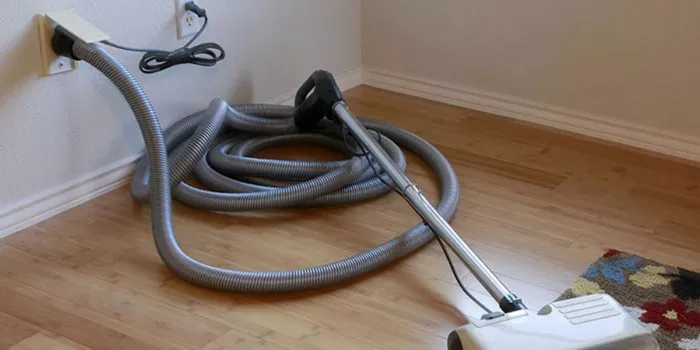A central vacuum cleaner is an innovative cleaning system installed in homes to provide powerful and convenient cleaning. Unlike traditional vacuum cleaners, a central vacuum system is a semi-permanent fixture with a network of pipes running through the walls of your home, leading to a central power unit, usually located in a garage or basement. The system utilizes inlets placed throughout the house, allowing users to attach a lightweight hose to vacuum different areas without having to carry a heavy unit from room to room.
The benefits of a central vacuum system are numerous: superior cleaning power, reduced noise since the motor is located away from living areas, and the ability to improve indoor air quality by venting exhaust outdoors. However, like any advanced appliance, central vacuum systems require regular maintenance to function at their best. One of the key aspects of maintaining these systems is regularly emptying the canister and performing basic upkeep tasks.
The canister unit, where all the collected debris is stored, is typically found in less frequented areas of the home, such as the garage, basement, or a utility room. This central location helps to centralize maintenance activities and minimize noise during operation.
Step-by-Step Guide on Emptying the Canister
Turning Off the System:
Before starting any maintenance, ensure the central vacuum system is turned off. This prevents any accidental activation and ensures your safety while handling the canister.
Disengaging the Canister:
Different central vacuum systems have various locking mechanisms. Refer to your manufacturer’s manual to understand how to unlock and remove the canister. Typically, this involves twisting or unlatching a set of clips or handles.
See also: Why Does My Vacuum Have Weak Suction
Safely Transporting the Canister Outdoors:
Once disengaged, carefully carry the canister outside. This step is crucial to prevent dust and debris from re-entering your home environment.
Emptying the Contents into a Trash Bin:
Slowly pour the contents into a trash bin to avoid creating dust clouds. For added safety, consider wearing a dust mask.
Wiping the Inside of the Canister (if needed):
After emptying, inspect the inside of the canister. If there is residual dirt or dust, use a damp cloth to wipe it clean. Ensure the canister is dry before reattaching it to the system.
Reattaching the Canister Securely:
Follow the reverse process of disengaging to reattach the canister. Make sure it is locked firmly in place to ensure no air leaks during operation.
Basic Maintenance
Importance of Cleaning Filters
Filters play a crucial role in maintaining the efficiency and longevity of your central vacuum system. They capture fine dust particles and prevent them from circulating back into your home. Regular cleaning of these filters ensures that the system operates efficiently and helps maintain good indoor air quality.
Types of Filters in Central Vacuums
Cartridge Filters: These are cylindrical filters, often made from paper or synthetic materials, designed to trap fine particles. They are commonly found in modern central vacuum systems due to their effectiveness and ease of maintenance.
Cloth Filters: Made from fabric, these filters are more traditional and are usually reusable. They require periodic cleaning to maintain their filtering capabilities.
Frequency of Cleaning
Consult your manufacturer’s instructions for the recommended cleaning frequency of your specific filters. Generally, filters should be checked and cleaned every three months. However, this may vary based on usage and the type of debris typically vacuumed.
Cleaning the Filter
Cartridge Filters:
Remove the filter from the canister according to the manufacturer’s instructions.
Rinse the filter under running water to remove accumulated dust and dirt. Avoid using harsh detergents as they can damage the filter material.
Allow the filter to air dry completely before reinstalling it. This prevents moisture from entering the motor or other parts of the system.
Cloth Filters:
Detach the cloth filter from the system.
Shake the filter vigorously over a trash bag to dislodge dust and debris. For thorough cleaning, you can also wash the filter with mild detergent and water.
Allow the filter to dry completely before reattaching it to the system.
See also: Why Does My Vacuum Lose Suction
Replacing Filters
Over time, filters can become worn out and lose their effectiveness. Adhering to the manufacturer’s recommendations for filter replacement ensures your system continues to function optimally. Generally, filters should be replaced every 1-2 years, but this can vary based on usage and environmental factors.
Additional Maintenance Tips
Depending on your model, there may be additional maintenance tasks to ensure your central vacuum system operates smoothly:
Cleaning the Inlet Screen: The inlet screen can accumulate dust and debris, which may obstruct airflow. Use a soft brush to gently clean the screen regularly.
Checking Hoses and Inlets for Clogs: Periodically inspect the hoses and inlets for any blockages. Use a long, flexible brush or a special attachment designed for central vacuum systems to clear any clogs.
Conclusion
Regular emptying and maintenance of your central vacuum system are essential for ensuring its efficient operation and longevity. By following the guidelines for emptying the canister and cleaning or replacing filters, you can maintain optimal performance and enjoy the benefits of a clean and healthy home environment. For more complex issues or thorough servicing, consider consulting a professional technician who specializes in central vacuum systems. Their expertise can help diagnose and resolve problems that regular maintenance might not cover, ensuring your system remains in top condition for years to come.

